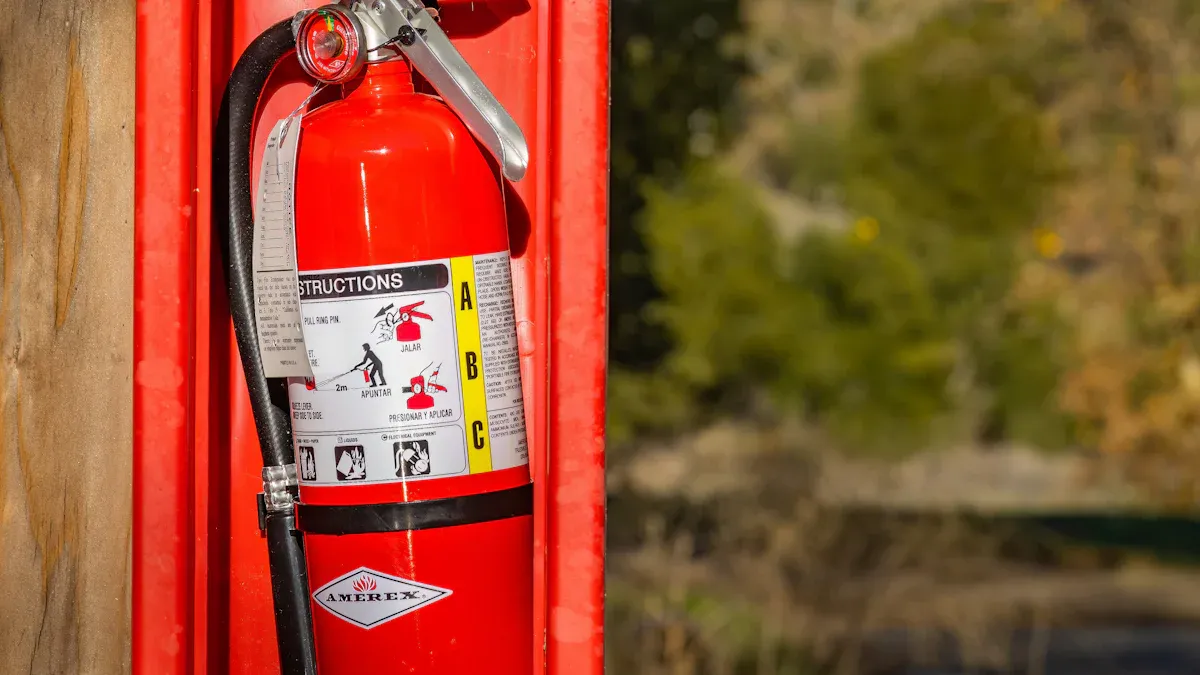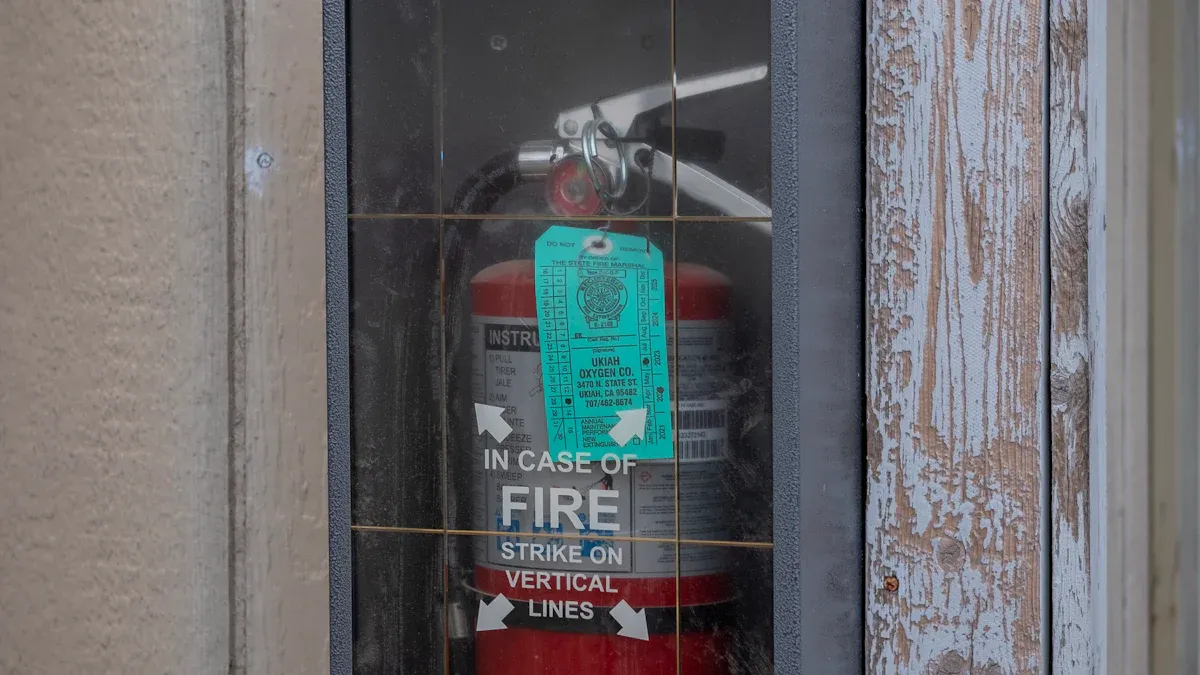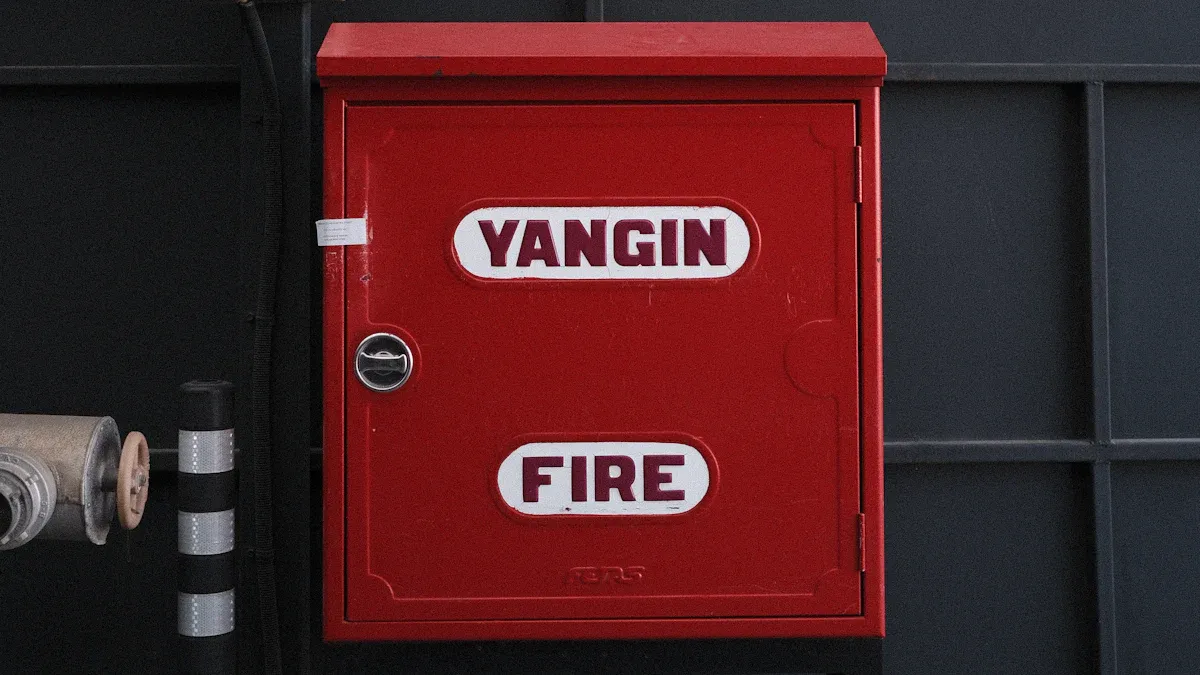
Modern fire extinguisher cabinet designs, such as recessed or modular types, help factories save space and improve safety. Many facilities now combine fire hose, CO2 fire extinguisher, fire hose reel, and hose reel cabinet features into compact units. Smart sensors and corrosion-resistant materials further boost efficiency and reliability.
Key Takeaways
- Modern fire extinguisher cabinets like recessed and modular designs save space and improve safety in industrial settings.
- Proper placement and maintenance of fire extinguisher cabinets ensure quick access and compliance with safety codes.
- Using durable materials and smart features helps keep fire safety equipment reliable and easy to use in busy workplaces.
Fire Extinguisher Cabinet Challenges in Industrial Space Management
Space Constraints in Industrial Facilities
Industrial facilities often struggle with limited space. Large machinery, storage racks, and production lines fill most areas. Facility managers must find room for safety equipment without blocking walkways or work zones. A case study from a three-floor office building in Saudi Arabia showed that fire extinguishers were sometimes too far from workers, not visible, or not mounted correctly. Inspection records were missing for years. These problems can also happen in factories and warehouses. When fire extinguishers are hard to find or reach, safety risks increase.
Fire Extinguisher Cabinet Safety and Accessibility Requirements
Safety codes require that every fire extinguisher remains easy to see and reach. Cabinets must not block exits or create hazards. The table below shows important compliance details:
| Compliance Aspect | Supporting Details |
|---|---|
| Monthly Visual Inspections | Ensure extinguisher is visible, accessible, safety pin intact, pressure gauge functional; fix issues immediately. |
| Annual Maintenance Checks | Certified technicians verify functionality, inspect parts, recharge or repair as needed to meet safety codes. |
| Hydrostatic Testing | Periodic pressure integrity tests prevent extinguisher failure due to weakened canisters, ensuring reliability. |
| Proper Mounting & Placement | Extinguishers must be mounted 3-5 feet high, visible, not blocked; placement near exits, kitchens, storage, etc. |
| Signage and Labels | Clear, reflective signs above or near extinguishers improve visibility, aiding quick location during emergencies. |
| Recordkeeping | Document location, type, serial number, inspection and maintenance dates to ensure ongoing compliance and readiness. |
ADA guidelines also stress the need for accessibility. Recessed cabinets or special brackets help keep fire extinguishers within reach for everyone, including wheelchair users. Photoluminescent signs make them easier to find during power outages.
Balancing Fire Extinguisher Cabinet Placement and Workflow
Facility managers must balance safety with efficient workflow. Placing a fire extinguisher cabinet in the wrong spot can block equipment or slow down workers. Good planning keeps safety equipment close but out of the way. Managers often use floor plans to test different locations. They look for spots that meet safety codes and do not disrupt daily tasks. This careful approach helps protect workers and keeps operations running smoothly.
Recent Fire Extinguisher Cabinet Design Innovations

Recessed Fire Extinguisher Cabinet Solutions
Recessed fire extinguisher cabinets have become a popular choice in modern industrial and commercial spaces. These cabinets fit into the wall, saving valuable floor space and reducing the risk of accidental bumps or obstructions. Many new building projects now use recessed cabinets because they offer both practical and stylish solutions. Manufacturers like Yuyao World Fire Fighting Equipment Factory provide cabinets made from stainless steel, aluminum, and other corrosion-resistant materials. These materials help the cabinets last longer, even in harsh environments.
- Recessed cabinets allow quick access to firefighting equipment during emergencies.
- Customization options include alarms and waterproof seals for extra protection.
- These cabinets meet important certifications such as UL, ISO9001, and IP66, ensuring quality and reliability.
Recessed cabinets also come in different installation styles, such as semi-recessed and surface mount, making them adaptable for many industries. Their design helps prevent fire damage and supports compliance with fire safety standards.
Modular and Customizable Fire Extinguisher Cabinet Systems
Modular fire extinguisher cabinet systems give facility managers flexibility. They can add or remove units as needs change. This approach works well in factories and warehouses where layouts often shift. Yuyao World Fire Fighting Equipment Factory offers modular systems that combine fire extinguishers, hose reels, and alarms in one unit. These systems can be tailored to fit unique industrial requirements.
Tip: Modular cabinets help companies adjust quickly to new safety regulations or workflow changes.
Customizable features include color options, locking mechanisms, and integrated signage. These options improve visibility and security. Modular systems also support the integration of smart technology, such as IoT sensors, for real-time monitoring and predictive maintenance. This trend aligns with Industry 4.0, where connected devices improve operational efficiency and safety.
Multi-Functional and Integrated Fire Extinguisher Cabinet Units
Multi-functional cabinets combine several fire safety tools in one compact unit. For example, a single cabinet may hold a fire extinguisher, hose reel, and first aid kit. This design saves space and keeps essential equipment together. In some advanced models, AI-powered sensors detect fire hazards and send alerts to facility managers. These smart cabinets use infrared thermal imaging and environmental data analysis to reduce false alarms and speed up evacuation.
A recent case from a university campus in California showed that integrating AI and IoT sensors into fire safety systems improved response times and reduced false alarms. Data centers now use clean agent suppression systems in their cabinets to protect sensitive equipment without causing damage. These innovations show a clear move toward smart, connected fire safety solutions in industrial environments.
Durable, Low-Profile Fire Extinguisher Cabinet Materials
Material choice plays a key role in cabinet durability and performance. Many modern cabinets use advanced composites like carbon-fiber-reinforced polymers (CFRPs), aramid-fiber-reinforced polymers (AFRPs), and glass-fiber-reinforced polymers (GFRPs). These materials make the cabinets lighter and more resistant to corrosion than traditional steel. Yuyao World Fire Fighting Equipment Factory uses injection-molded frames with UV inhibitors and thick acrylic thermoplastic panels. These features protect cabinets from UV damage, rust, dents, and weather.
Plastic cabinets often include pitched roofs to prevent water pooling and natural ventilation to keep contents dry. Plexiglass fronts avoid the risk of shattered glass, making them safer in busy industrial settings. These design choices ensure that cabinets remain reliable and easy to maintain, even in tough environments.
| Material Type | Benefits | Common Uses |
|---|---|---|
| CFRP/AFRP/GFRP | Lightweight, corrosion-resistant | Industrial, marine, outdoor areas |
| Stainless Steel | High strength, long lifespan | Factories, warehouses |
| Acrylic/Plastic | UV-resistant, dent-proof, lightweight | Food processing, chemical plants |
Space-Saving Strategies with Fire Extinguisher Cabinet Innovations

Maximizing Wall Space with Fire Extinguisher Cabinet Placement
Industrial facilities often face crowded walls filled with equipment, signage, and storage. Facility managers use innovative cabinet designs to make the most of every inch. Recessed cabinets fit into the wall, so they do not stick out into walkways or work areas. This approach keeps fire safety equipment close at hand while freeing up valuable space for other needs.
Some facilities use vertical stacking to place multiple cabinets in a single wall section. This method works well in areas with high ceilings. Managers also choose slim-profile cabinets that fit between structural supports or machinery. These strategies help keep walls organized and uncluttered.
Tip: Use wall-mounting templates to plan cabinet placement before installation. This step helps avoid conflicts with pipes, electrical panels, or doors.
Optimizing Floor Space and Traffic Flow Using Fire Extinguisher Cabinets
Floor space in industrial environments is always at a premium. Poorly placed cabinets can block pathways or create trip hazards. Modern cabinet innovations address these issues by reducing the footprint of each unit. Recessed and low-profile cabinets do not extend into aisles, so workers and equipment can move freely.
Facility planners often map out traffic patterns to find the best locations for cabinets. They avoid placing units near corners or busy intersections. Instead, they select spots along main corridors or near exits. This approach keeps escape routes clear and supports fast emergency response.
The table below shows common placement strategies and their benefits:
| Placement Strategy | Benefit |
|---|---|
| Recessed wall mounting | Saves floor space, reduces hazards |
| Corner avoidance | Improves visibility, prevents crowding |
| Near exits and corridors | Supports quick access in emergencies |
Enhancing Accessibility Without Obstruction Through Fire Extinguisher Cabinet Design
Accessibility remains a top priority in every industrial setting. Designers create cabinets that meet ADA guidelines and local safety codes. Recessed and semi-recessed models keep equipment within reach for all workers, including those who use wheelchairs.
Clear signage and photoluminescent labels help everyone find the nearest cabinet, even during power outages. Some facilities add audible alarms or strobe lights to alert workers when a cabinet opens. These features improve response times and reduce confusion during emergencies.
Facility managers also choose cabinets with easy-open handles and break-glass panels. These designs allow quick access without tools or special training. By focusing on accessibility, companies ensure that every worker can use fire safety equipment when needed.
Real-World Applications of Fire Extinguisher Cabinet Innovations
Manufacturing Facilities Using Recessed Fire Extinguisher Cabinets
Manufacturing plants often have tight spaces filled with machines and conveyor belts. Facility managers choose recessed fire extinguisher cabinets to keep walkways clear. These cabinets fit into the wall, so workers do not bump into them. In a car parts factory, the safety team installed recessed units near high-risk areas. Workers found the cabinets easy to spot and reach during drills. The cabinets also stayed clean and undamaged, even in busy zones.
Warehouses Implementing Modular Fire Extinguisher Cabinet Systems
Warehouses need flexible safety solutions because storage layouts change often. Modular fire extinguisher cabinet systems help managers adapt to new needs. For example, a logistics company in Texas used modular cabinets that could move with shifting inventory racks. The team added extra units during peak seasons. This approach kept fire protection close to workers at all times.
Note: Modular systems allow quick upgrades or repairs without major changes to the building.
Distribution Centers with Integrated Fire Extinguisher Cabinet Solutions
Distribution centers handle large volumes of goods and see heavy foot traffic. Managers use integrated fire extinguisher cabinet solutions that combine extinguishers, alarms, and first aid kits. In a food distribution center, the staff placed these units near loading docks and exits. Workers responded faster during safety drills because all emergency tools were in one place. Integrated cabinets also made inspections easier for safety officers.
Selecting and Implementing Fire Extinguisher Cabinet Innovations
Assessing Industrial Layout Needs for Fire Extinguisher Cabinets
Facility managers must evaluate several factors before choosing a fire extinguisher cabinet. They consider the type of fire hazards, the layout of the workspace, and how easily employees can reach safety equipment. The National Fire Protection Association’s Standard No. 10 sets clear rules for spacing and coverage. Managers also check if cabinets can be mounted at the right height and if employees can access them without ladders. Training staff to know cabinet locations and ensuring coverage around obstacles like machinery or columns helps keep everyone safe.
- Identify fire hazard classes (A, B, C, D)
- Measure spacing to reach around obstructions
- Confirm mounting height and accessibility
- Ensure quick and safe access for all employees
- Use flexible mounting in areas with heavy traffic
- Train staff on cabinet locations and use
Choosing the Right Fire Extinguisher Cabinet Innovations
Selecting the best cabinet depends on the environment and specific needs. The table below compares options:
| Aspect | Options/Types | Suitability/Considerations |
|---|---|---|
| Cabinet Type | Surface-Mounted, Recessed, Semi-Recessed | Surface-mounted for warehouses; recessed for offices; semi-recessed for tight spaces |
| Material | Steel, Aluminum, Plastic | Steel is strong; aluminum resists rust; plastic handles moisture well |
| Features | Locks, Alarms, Glass/Acrylic Panels | Locks and alarms add security; glass panels allow quick checks |
| Environmental Factors | Humidity, Temperature, Exposure | Choose materials and features based on climate and exposure |
| Accessibility & Codes | ADA compliance, mounting height | Recessed or semi-recessed cabinets help meet accessibility standards |
Installation Best Practices for Fire Extinguisher Cabinets
Proper installation ensures safety and compliance. Installers should use wall-mounting templates to avoid pipes and electrical panels. Cabinets must sit at the correct height and not block exits or walkways. Facility managers should check that signage is visible and that the cabinet does not stick out more than allowed by code. In high-traffic areas, retractable boards or recessed cabinets prevent accidents.
Tip: Always double-check local codes before installing any fire extinguisher cabinet.
Maintenance and Compliance for Fire Extinguisher Cabinets
Regular maintenance keeps cabinets ready for emergencies. Monthly inspections help spot problems early. Staff should check for damage, confirm pressure gauges are in range, and update inspection tags. Records must be kept for at least 12 months. Annual professional maintenance and hydrostatic testing ensure full functionality. Digital tools can help schedule and track inspections. Clear labels and easy access support compliance and safety.
- Facility managers see measurable improvements in space and efficiency with new cabinet designs.
- Advanced solutions help teams organize equipment and improve safety.
- Safety planners who choose innovative options create better workflows and safer industrial layouts.
FAQ
What are the main benefits of recessed fire extinguisher cabinets?
Recessed cabinets save floor space and reduce hazards. Workers find them easy to access. Facility managers prefer them for high-traffic industrial areas.
How often should fire extinguisher cabinets receive inspections?
Safety experts recommend monthly visual checks and annual professional maintenance. Regular inspections help ensure equipment stays ready for emergencies.
Which materials work best for industrial fire extinguisher cabinets?
| Material | Key Benefit |
|---|---|
| Stainless Steel | High durability |
| Plastic/Acrylic | Lightweight, rustproof |
| Composite Fibers | Corrosion resistance |
Facility managers select materials based on environment and safety needs.
Post time: Jul-08-2025

